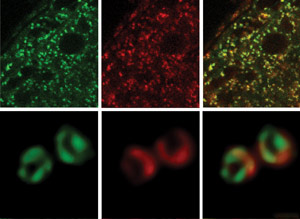Sep. 26, 2014 Research Highlight Biology
Hunting GNOM
Honing in on the localization of an elusive membrane trafficking regulator called GNOM suggests a new cellular model for protein recycling in plants
 Figure 1: Microscope images showing the localization of GNOM (green; left and right) and GNOM-LIKE1 (red; center and right) within the Golgi apparatus of Arabidopsis plants. The top row shows root cells imaged by standard confocal laser scanning microscopy, while the bottom row shows images of individual Golgi stacks obtained by super-resolution confocal live imaging microscopy. Reproduced, with permission, from Ref. 1 © 2014 American Society of Plant Biologists
Figure 1: Microscope images showing the localization of GNOM (green; left and right) and GNOM-LIKE1 (red; center and right) within the Golgi apparatus of Arabidopsis plants. The top row shows root cells imaged by standard confocal laser scanning microscopy, while the bottom row shows images of individual Golgi stacks obtained by super-resolution confocal live imaging microscopy. Reproduced, with permission, from Ref. 1 © 2014 American Society of Plant Biologists
The transport of hormones and other substances across cell membranes is crucial for cell function and correct organism development. Probing the molecular and cellular mechanisms involved in the process, however, can be challenging. Using a combination of state-of-the-art techniques, an international team of researchers including Satoshi Naramoto and Akihiko Nakano from the RIKEN Molecular Membrane Biology Laboratory has now pinpointed the location of one of the key regulators of cross-membrane transport in plant cells, GNOM1.
The process of absorbing substances across cell membranes is known as endocytosis. Proteins localized at the cell membrane become internalized to organelles called endosomes and are subsequently recycled back to the cell membrane. GNOM is a membrane trafficking regulator that has been thought to play a crucial role in recycling endocytosed proteins. Plants with mutant gnom genes display highly dwarfed growth forms, indicative of defective transport of the growth hormone auxin. However, despite considerable research in the area, GNOM’s exact localization and function have proved elusive.
Previous studies had shown that GNOM was localized to recycling endosomes, but Naramoto and his colleagues unexpectedly found GNOM in the Golgi apparatus—a complex organelle with functions including intracellular and extracellular transport. Using time-lapse imaging, the researchers also showed that a chemical employed in previous studies to stabilize GNOM’s position in fact caused the regulator to be translocated to the endosomes, explaining the earlier results.
The researchers then used a new technique called super-resolution confocal live imaging microscopy to visualize the position of GNOM within the stacks of membranes making up the Golgi and distinguish it from a closely related protein GNOM-LIKE1 (GNL1). They found that GNOM formed a prominent ring at the margin of the stacks, overlapping but not identical to the distribution of GNL1 (Fig. 1). The results show that the tiny Golgi stacks contain multiple secretory systems.
The findings also raise questions about the subcellular location of protein recycling. “Our results suggest that protein recycling is in fact a function of the Golgi apparatus in plants.” Further investigation of gnom mutants indicated that GNOM helps maintain the structure of the trans Golgi network and early endosome, indirectly influencing protein recycling. The research highlights the interconnectedness of all organelles, which are linked by continuous membrane transport within the plant cell. Naramoto, who is now at the University of Tokyo, hopes that future work will lead to an even more detailed characterization of the essential pathways of protein recycling and of the recycling endosomes themselves.
References
- 1. Naramoto, S., Otegui, M. S., Kutsuna, N., de Rycke, R., Dainobu, T., Karampelias, M., Fujimoto, M., Feraru, E., Daisuke, M., Fukuda, H., et al. Insights into the localization and function of the membrane trafficking regulator GNOM ARF-GEF at the Golgi apparatus in Arabidopsis. The Plant Cell 26, 3062–3076 (2014). doi: 10.1105/tpc.114.125880
